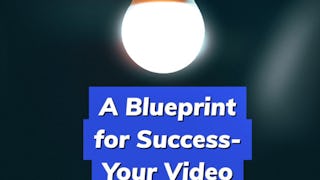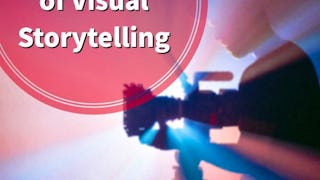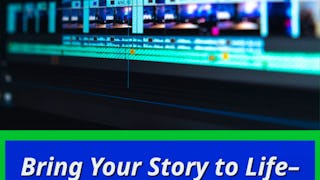Si vous avez mené à bien votre préproduction, vous devriez pouvoir passer en toute confiance à l'étape suivante, qui consiste à rassembler les matériaux bruts que vous utiliserez pour construire votre histoire visuelle. Ces matières premières sont vos prises de vue, y compris les rouleaux B et les interviews. L'étape de la production est celle où vous recueillerez enfin les images et le son qui communiqueront directement avec votre public. Nous vous montrerons comment améliorer votre histoire visuelle en rehaussant la qualité de vos prises de vue : obtenir une exposition correcte, utiliser la règle des tiers et tourner des séquences qui favorisent la continuité. Nous aborderons également l'importance du son dans votre production, de l'enregistrement des sons naturels aux interviews. Vous souhaitez ajouter de l'ambiance et de l'atmosphère à vos interviews ? Nous vous apprendrons à éclairer une interview pour aider votre sujet à se mettre en valeur. Considérez vos images comme des preuves visuelles qui montrent, et non pas seulement racontent, votre histoire.

Profitez d'une croissance illimitée avec un an de Coursera Plus pour 199 $ (régulièrement 399 $). Économisez maintenant.

Prêt à tourner - Le processus de production vidéo
Ce cours fait partie de Spécialisation L'art de la narration visuelle


Instructeurs : Emilie Johnson
6 317 déjà inscrits
Inclus avec
(32 avis)
Expérience recommandée
Ce que vous apprendrez
Comment faire fonctionner un caméscope prosommateur en mode manuel.
Comment identifier certains plans et mouvements de caméra.
Cadrer les prises de vue à l'aide de la règle des tiers.
Réaliser des séquences qui favorisent la continuité.
Compétences que vous acquerrez
- Catégorie : Vidéographie
- Catégorie : Production médiatique
- Catégorie : Narration
- Catégorie : Production vidéo
- Catégorie : Édition
- Catégorie : Cinématographie
Détails à connaître

Ajouter à votre profil LinkedIn
8 devoirs
Découvrez comment les employés des entreprises prestigieuses maîtrisent des compétences recherchées

Élaborez votre expertise du sujet
- Apprenez de nouveaux concepts auprès d'experts du secteur
- Acquérez une compréhension de base d'un sujet ou d'un outil
- Développez des compétences professionnelles avec des projets pratiques
- Obtenez un certificat professionnel partageable

Il y a 7 modules dans ce cours
Dans ce module, vous découvrirez les fonctions de base de la plupart des caméscopes grand public et vous apprendrez à réaliser les meilleures prises de vue possibles. Tout d'abord, nous allons vous expliquer ce que le caméscope de base peut faire pour vous. Nous vous montrerons comment utiliser le caméscope en mode automatique et en mode manuel. Nous vous montrerons les caractéristiques de la plupart des trépieds, comment obtenir des prises de vue de niveau et comment monter et démonter le caméscope. Vous apprendrez également à connaître les termes que nous utilisons pour décrire les mouvements de la caméra, et nous vous suggérerons des choses à faire et à ne pas faire. La caméra tremblante fait sentir sa présence, ce qui peut être gênant pour votre public. Enfin, nous vous donnerons quelques conseils pour vous aider à stabiliser la caméra, même lorsque vous l'utilisez à main levée.
Inclus
5 vidéos1 lecture1 devoir
Dans ce module, vous en apprendrez davantage sur l'élément fondamental de la narration visuelle : la prise de vue. Pour savoir quelles prises de vue réaliser, vous devez d'abord connaître votre histoire. Nous vous présenterons les outils que vous pouvez utiliser pour anticiper vos prises de vue en production, tels que les storyboards et les listes de prises de vue. Nous vous montrerons ce que vous devez faire lorsque vous arrivez sur le lieu de tournage à la recherche des meilleurs angles, et pourquoi il est important de "tourner et bouger" Nous vous montrerons comment cadrer vos prises de vue, ce qu'il faut faire et ne pas faire pour utiliser le zoom, et nous vous expliquerons la valeur du gros plan dans votre narration. Vous apprendrez ce qu'est la continuité et pourquoi il est important de respecter l'"axe" Nous vous donnerons également quelques conseils sur la mise au point et vous présenterons les fonctions d'aide à la mise au point que l'on trouve sur de nombreux caméscopes.
Inclus
4 vidéos1 lecture1 devoir1 sujet de discussion
Au lieu d'utiliser des mots, une histoire visuelle utilise la lumière. La manière de capturer et de contrôler la lumière est l'essence même d'une bonne photographie. Dans ce module, vous apprendrez à contrôler la lumière qui pénètre dans l'objectif et à obtenir une exposition correcte. Nous vous expliquerons les différentes parties d'un objectif, le filtre à densité neutre, le gain, la vitesse d'obturation et le diaphragme. Nous partagerons également avec vous quelques aides à l'exposition que l'on trouve dans de nombreux caméscopes. Vous apprendrez ce que signifie la balance des blancs pour vous aider à reproduire les couleurs avec précision. En outre, nous vous présenterons les meilleures pratiques en matière de prise de vue sur votre smartphone, y compris les applications qui permettent d'étendre la capacité de votre téléphone à filmer des vidéos. Si vous cherchez un moyen plus économique de filmer, ce module vous montrera comment tirer le meilleur parti de la caméra de votre smartphone.
Inclus
4 vidéos3 lectures1 devoir
Une bonne composition attire notre regard sur la partie la plus importante de la photo. En revanche, une mauvaise composition peut donner l'impression que vos images sont faibles et qu'elles ne transmettent pas l'énergie et le mouvement. Dans ce module, nous allons partager avec vous quelques conseils sur la façon de composer vos photos de manière à susciter l'intérêt. Nous vous présenterons la règle des tiers et nous vous montrerons comment donner de la profondeur à votre image en utilisant des lignes directrices qui guident notre regard vers le sujet. Nous vous expliquerons également pourquoi les interviews jouent un rôle si important dans votre récit. Les bonnes compositions d'interviews suivent la règle des tiers de manière assez rigide, et si ce n'est pas le cas, ce sont les photos que vous devrez peut-être reprendre. Nous allons vous donner quelques conseils sur la manière de bien cadrer les interviews, de manière à susciter notre intérêt. Les gros plans sont la façon la plus courante de cadrer les interviews, où l'invité est vu de trois-quarts et où ses yeux sont au niveau de l'objectif. Nous vous donnerons également quelques conseils pour rendre l'arrière-plan plus intéressant et moins distrayant.
Inclus
2 vidéos1 lecture1 devoir
La narration visuelle trouve des moyens de transmettre une expérience en montrant l'action qui progresse d'un plan à l'autre. Cette progression est un moyen de renforcer l'implication du spectateur dans l'histoire et de maintenir son intérêt. Dans ce module, nous expliquerons comment les séquences peuvent rendre vos histoires plus attrayantes à regarder, comment elles favorisent la continuité et même comment elles réduisent le temps nécessaire à l'accomplissement d'une action unique. L'épine dorsale de la narration visuelle est la séquence, qui consiste en une variété de plans montrant la même action sous différentes perspectives. Les séquences favorisent non seulement la continuité, mais elles donnent aussi à votre vidéo un aspect professionnel. Les séquences sont le fondement de la narration visuelle et elles permettent de créer un flux de travail plus efficace pour votre montage. En tant que photographe, il est important de planifier à l'avance la manière dont vous allez monter les prises de vue ensemble, afin que votre montage apparaisse fluide et dynamique. Tout simplement, en tant que photographe, pensez comme un monteur. Nous allons vous expliquer comment planifier votre séquence, en filmant avec intention au lieu de filmer tout ce qui est visible. En d'autres termes, vous filmez les séquences dans l'ordre dans lequel vous les verrez dans le montage final. Nous vous ferons également part de quelques stratégies pour "sauver les montages" en obtenant des plans de coupe pour résoudre les problèmes de continuité. Enfin, nous vous montrerons comment réaliser des transitions à l'intérieur de l'appareil photo afin de rendre vos montages plus dynamiques.
Inclus
2 vidéos1 lecture1 devoir1 sujet de discussion
Obtenir un bon son est tout aussi important qu'une bonne vidéo, si ce n'est plus. Dans ce module, vous apprendrez à identifier ce qui constitue un bon son et à l'enregistrer correctement. Vous apprendrez les termes qui décrivent la qualité audio et ce qui peut entraîner des problèmes audio. Nous expliquerons les microphones les plus couramment utilisés et pourquoi il est important d'utiliser le bon microphone pour le bon travail. Nous vous montrerons quelques astuces à utiliser lors de l'organisation d'interviews qui vous permettront d'obtenir les résultats audio que vous souhaitez. Nous décrirons l'importance des microphones à pince, comment éviter que le vent et d'autres bruits ambiants ne gâchent votre son, et comment improviser votre propre cabine audio pour l'enregistrement d'une narration.
Inclus
4 vidéos2 lectures1 devoir1 sujet de discussion
L'éclairage est autant un art qu'une science exacte. Quelques éclairages supplémentaires permettront à vos sujets d'apparaître sous leur meilleur jour, sans ombres disgracieuses, sans éclairage plat et sans sous-exposition. Dans ce module, nous vous apprendrons à éclairer vos prises de vue, en particulier les interviews, à l'aide d'éclairages à un, deux et trois points. Nous expliquerons la valeur de l'éclairage et la manière dont l'éclairage peut véhiculer des émotions. Nous identifierons les termes utilisés pour décrire l'éclairage, tels que lumière sombre et lumière vive, high key vs low key, et high contrast vs low contrast. Nous vous montrerons ce que fait une lumière clé et comment l'éclairage peut donner une impression de profondeur. Nous vous expliquerons également comment la direction de l'éclairage peut donner un aspect plus dramatique à l'image et comment improviser en utilisant l'éclairage disponible, y compris la lumière du soleil, et les façons dont vous pouvez atténuer les ombres dures à l'aide de la diffusion.
Inclus
8 vidéos2 lectures2 devoirs1 évaluation par les pairs
Obtenez un certificat professionnel
Ajoutez ce titre à votre profil LinkedIn, à votre curriculum vitae ou à votre CV. Partagez-le sur les médias sociaux et dans votre évaluation des performances.
Instructeurs


Offert par
En savoir plus sur Développement personnel
 Statut : Essai gratuit
Statut : Essai gratuitUniversity of Colorado Boulder
 Statut : Essai gratuit
Statut : Essai gratuitUniversity of Colorado Boulder
 Statut : Essai gratuit
Statut : Essai gratuitUniversity of Colorado Boulder
 Statut : Essai gratuit
Statut : Essai gratuit
Pour quelles raisons les étudiants sur Coursera nous choisissent-ils pour leur carrière ?




Avis des étudiants
32 avis
- 5 stars
87,87 %
- 4 stars
6,06 %
- 3 stars
0 %
- 2 stars
0 %
- 1 star
6,06 %
Affichage de 3 sur 32
Révisé le 20 déc. 2024
Grading on the last certificate is taking entirely too long!! I have been waiting for about two weeks. Am I doing something wrong?
Révisé le 29 oct. 2024
This course is a solid foundation for everyone who starts learning about creation videos. It's so helpful and informative. Love it.

Ouvrez de nouvelles portes avec Coursera Plus
Accès illimité à 10,000+ cours de niveau international, projets pratiques et programmes de certification prêts à l'emploi - tous inclus dans votre abonnement.
Faites progresser votre carrière avec un diplôme en ligne
Obtenez un diplôme auprès d’universités de renommée mondiale - 100 % en ligne
Rejoignez plus de 3 400 entreprises mondiales qui ont choisi Coursera pour les affaires
Améliorez les compétences de vos employés pour exceller dans l’économie numérique
Foire Aux Questions
Aucune connaissance particulière n'est requise. Ce cours s'attaque de front à la production vidéo et explique les concepts nécessaires.
Oui, les cours doivent être suivis dans l'ordre dans lequel ils sont proposés. Chaque cours s'appuie sur le précédent.
Non, cette spécialisation ne peut pas être suivie pour l'obtention d'un crédit universitaire.
Plus de questions
Aide financière disponible,

